A Space Inertial Sensor Ground Evaluation System for Non-Sensitive Axis Based on Torsion Pendulum
Abstract
1. Introduction
2. Sensing and Actuation Principle
2.1. Differential Capacitance Sensing
2.2. Electrode Configuration
2.3. Electrostatic Actuation
3. System Design
3.1. Sensitive Structure Design
3.2. Measurement and Control Unit
3.3. Torsion Pendulum Facility
4. Ground Evaluation Experiment
4.1. Experimental Setup
4.2. Control Ability Experiment
4.3. Acceleration Noise and Resolution Evaluation
5. Conclusions
Author Contributions
Funding
Acknowledgments
Conflicts of Interest
References
- Abbott, B.P.; Abbott, R.; Abbott, T.D.; Abernathy, M.R.; Acernese, F.; Ackley, K.; Adams, C.; Adams, T.; Addesso, P.; Adhikari, R.X.; et al. GW150914: The Advanced LIGO Detectors in the Era of First Discoveries. Phys. Rev. Lett. 2016, 116, 131103. [Google Scholar] [CrossRef] [PubMed]
- Chen, Q.; Mariethoz, G.; Liu, G.; Comunian, A.; Ma, X. Locality-based 3-D multiple-point statistics reconstruction using 2-D geological cross-sections. Hydrol. Earth Syst. Sci. Discuss. 2018, 1–31. [Google Scholar] [CrossRef]
- Li, Y.; Liu, H.; Zhao, Y.; Sha, W.; Wang, Z.; Luo, Z.; Jin, G. Demonstration of an Ultraprecise Optical Bench for the Taiji Space Gravitational Wave Detection Pathfinder Mission. Appl. Sci. 2019, 9, 2087. [Google Scholar] [CrossRef]
- Liu, H.; Luo, Z.; Jin, G. The Development of Phasemeter for Taiji Space Gravitational Wave Detection. Microgravity Sci. Technol. 2018, 30, 775–781. [Google Scholar] [CrossRef]
- Jin, G. Program in space detection of gravitational wave in Chinese Academy of Sciences. J. Phys. Conf. Ser. 2017, 840, 12009. [Google Scholar] [CrossRef]
- Cyranoski, D. Chinese gravitational-wave hunt hits crunch time. Nat. News 2016, 531, 150–151. [Google Scholar] [CrossRef] [PubMed]
- Luo, Z.; Liu, H.; Jin, G. The recent development of interferometer prototype for Chinese gravitational wave detection pathfinder mission. Opt. Laser Technol. 2018, 105, 146–151. [Google Scholar] [CrossRef]
- China’s Taiji-1 Satellite Successfully Passes In-Orbit Tests. Available online: https://www.apdnews.com/science-military/977140.html (accessed on 26 December 2019).
- Josselin, V.; Rodrigues, M.; Touboul, P. Inertial sensor concept for the gravity wave missions. Acta Astronaut. 2001, 49, 95–103. [Google Scholar] [CrossRef]
- Touboul, P.; Willemenot, E.; Foulon, B.; Josselin, V. Accelerometers for CHAMP, GRACE and GOCE space missions: Synergy and evolution. Boll. Geof. Teor. Appl. 1999, 40, 321–327. [Google Scholar]
- Lauben, D.; Allen, G.; Bencze, W.; Buchman, S.; Byer, R.; Goh, A.; Dorlybounxou, S.; Hanson, J.; Ho, L.; Higuchi, S.; et al. Electrostatic sensing and forcing electronics performance for the LISA Pathfinder gravitational reference sensor. AIP Conf. Proc. 2006, 873, 576–582. [Google Scholar] [CrossRef]
- Danzmann, K. LISA mission overview. Adv. Space Res. 2000, 25, 1129–1136. [Google Scholar] [CrossRef]
- Luo, Z.-R.; Zhong, M.; Bian, X.; Dong, P.; Dong, Y.; Gao, W.; Li, H.; Li, Y.; Liu, H.; Ran, J.; et al. Mapping Earth’s gravity in space: Review and future perspective. Adv. Mech. 2014, 44, 201408. [Google Scholar]
- Nobili, A.M.; Anselmi, A. Relevance of the weak equivalence principle and experiments to test it: Lessons from the past and improvements expected in space. Phys. Lett. A 2018, 382, 2205–2218. [Google Scholar] [CrossRef]
- Moe, K.; DeBra, D.B.; Van Patten, R.A.; Moe, M.M.; Oelker, G.; Ruggera, M.B. Exospheric density measurements from the drag-free satellite Triad. J. Geophys. Res. Space Phys. 1976, 81, 3753–3761. [Google Scholar] [CrossRef]
- Huang, T.; Lühr, H.; Wang, H.; Xiong, C. The Relationship of High-Latitude Thermospheric Wind with Ionospheric Horizontal Current, as Observed by CHAMP Satellite. J. Geophys. Res. Space Phys. 2017, 122, 12378. [Google Scholar] [CrossRef]
- Frappart, F.; Ramillien, G. Monitoring Groundwater Storage Changes Using the Gravity Recovery and Climate Experiment (GRACE) Satellite Mission: A Review. Remote Sens. 2018, 10, 829. [Google Scholar] [CrossRef]
- Buchman, S.; Everitt, C.; Parkinson, B.; Turneaure, J.; DeBra, D.; Bardas, D.; Bencze, W.; Brumley, R.; Gill, D.; Gutt, G.; et al. The Gravity Probe B Relativity Mission. Adv. Space Res. 2000, 25, 1177–1180. [Google Scholar] [CrossRef]
- Siemes, C. Improving GOCE cross-track gravity gradients. J. Geod. 2017, 92, 33–45. [Google Scholar] [CrossRef]
- Flechtner, F.; Morton, P.; Watkins, M.; Webb, F. Status of the GRACE Follow-On Mission; Springer Science and Business Media LLC: Berlin, Germany, 2014; Volume 141, pp. 117–121. [Google Scholar]
- Touboul, P.; Métris, G.; Rodrigues, M.; Baghi, Q.; Boulanger, D.; Bremer, S.; Carle, P.; Chhun, R.; Christophe, B.; Cipolla, V.; et al. MICROSCOPE Mission: First Results of a Space Test of the Equivalence Principle. Phys. Rev. Lett. 2017, 119, 231101. [Google Scholar] [CrossRef]
- Armano, M.; Audley, H.; Auger, G.; Baird, J.T.; Bassan, M.; Binetruy, P.; Born, M.; Bortoluzzi, D.; Brandt, N.; Caleno, M.; et al. Sub-Femto-gFree Fall for Space-Based Gravitational Wave Observatories: LISA Pathfinder Results. Phys. Rev. Lett. 2016, 116, 231101. [Google Scholar] [CrossRef]
- Bernard, A.; Touboul, P. Development of the High Sensitivity GRADIO Accelerometers-The Aristoteles Gradiometer Mission Preparation; NASA STI/Recon Technical Report A; SITEF: Toulouse, France, 1991; Volume 92. [Google Scholar]
- Stanga, R.; Marconi, L.; Bagni, G.; Grimani, C.; Vetrano, F.; Viceré, A.; Carbone, L.; Cavalleri, A.; Dolesi, R.; Hueller, M.; et al. Ground based 2DoF test for LISA and LISA PF. J. Phys. Conf. Ser. 2006, 32, 180–185. [Google Scholar] [CrossRef]
- Touboul, P.; Foulon, B. Astre Accelerometer: Verification Tests in Drop Tower Bremen, Office National Detudes Etde Recherches Aerospatiales Onera-Publications-Tp. 1996. Available online: http://www.opengrey.eu/item/display/10068/65887 (accessed on 26 April 2020).
- Cavalleri, A.; Ciani, G.; Dolesi, R.; Heptonstall, A.; Hueller, M.; Nicolodi, D.; Rowan, S.; Tombolato, D.; Vitale, S.; Wass, P.; et al. A new torsion pendulum for testing the limits of free-fall for LISA test masses. Class. Quantum Gravity 2009, 26, 94017. [Google Scholar] [CrossRef]
- Apple, S.M.; Chilton, A.; Olatunde, T.; Bickerstaff, B.; Hillsberry, D.; Parry, S.; Ciani, G.; Mueller, G.; Conklin, J. University of Florida Torsion Pendulum for Testing Key LISA Technology. AIAA Space Astronaut. Forum Expo. 2017, 5138. [Google Scholar] [CrossRef]
- Li, G.; Wu, S.C.; Zhou, Z.B.; Bai, Y.Z.; Hu, M.; Luo, J. Design and validation of a high-voltage levitation circuit for electrostatic accelerometers. Rev. Sci. Instrum. 2013, 84, 125004. [Google Scholar] [CrossRef]
- Tu, H.B.; Bai, Y.Z.; Zhou, Z.B.; Luo, J. Electrostatic-control performance measurement of the inertial sensor with a torsion pendulum. J. Phys. Conf. Ser. 2009, 154, 012036. [Google Scholar] [CrossRef]
- Li, H.-Y.; Qu, S.-B.; Bai, Y.-Z.; Wu, S.-C.; Zhou, Z. Least squares estimation of in-orbit mass center position of the electrostatic accelerometer. Chin. J. Geophys. 2017, 60, 897–902. [Google Scholar]
- Gao, S.-M.; Wang, Y.; Li, Y.-P. The Design of Transformer Bridge on Capacitance detection circuit of electrostatic levitation accelerometer. Vac. Cryog. 2017, 23, 297–300. [Google Scholar]
- Chen, G.-F.; Huo, H.-Q.; Wang, Z.-L.; Yin, D.; Lei, J.; Zhang, X.-B.; Xi, D. Ground High Voltage Suspension Theory and Applications for Electrostatic Accelerometer. Chin. Space Sci. Technol. 2015, 5, 56–63. [Google Scholar]
- Han, F.-T.; Wu, Q.-P.; Dong, J.-X. Displacement detection schemes for electrostatically levitated inertial instruments. J. Chin. Inst. Technol. 2007, 1, 72–76. [Google Scholar]
- Wu, L.-M.; Dong, J.-X.; Han, F.-T. Design and experiment of the detection circuit for electrostatically levitated accelerometers. Chin.J. Sci. Instrum. 2006, 12, 1569–1572. [Google Scholar]
- Liu, S.; Liu, Y.-F.; Dong, J.-X. Method for resolution estimation of electrostatically euspended accelerometer based on Power Spectrum Density (PSD). Instrum. Tech. Sens. 2015, 10, 30–34. [Google Scholar]
- Hu, W.-R.; Wu, Y.-L. The Taiji Program in Space for gravitational wave physics and the nature of gravity. Natl. Sci. Rev. 2017, 4, 685–686. [Google Scholar] [CrossRef]
- Josselin, V.; Touboul, P.; Kielbasa, R. Capacitive detection scheme for space accelerometers applications. Sens. Actuators A Phys. 1999, 78, 92–98. [Google Scholar] [CrossRef]
- Dietrich, R.; Fox, J.; Lange, W. An electrostatically suspended cube proofmass triaxial accelerometer for electric propulsion thrust measurement. In Proceedings of the 32nd Joint Propulsion Conference and Exhibt, Lake Buena Vista, FL, USA, 1–3 July 1996; Volume 2734. [Google Scholar] [CrossRef]
- Silvestrin, P. Control and Navigation Aspects of the New ESA Earth Observation Missions. IFAC Proc. Vol. 2004, 37, 13–24. [Google Scholar] [CrossRef]
- Wang, Y.; Qi, K.; Wang, S.; Li, W.; Li, Z.; Wang, Z. Capacitive sensing and electrostatic control system design and analysis with a torsion pendulum. IEEE Access 2020, 8, 1021–1030. [Google Scholar] [CrossRef]
- Willemenot, E.; Touboul, P. On-ground investigation of space accelerometers noise with an electrostatic torsion pendulum. Rev. Sci. Instrum. 2000, 71, 302–309. [Google Scholar] [CrossRef]
- Zhou, Z.B.; Liu, L.; Tu, H.B.; Bai, Y.Z.; Luo, J. Seismic noise limit for ground-based performance measurements of an inertial sensor using a torsion balance. Class. Quantum Gravity 2010, 27, 175012. [Google Scholar] [CrossRef]
- Peterson, J.R. Observations and Modeling of Seismic Background Noise; Open-File Report; U.S. Geological Survey: Reston, VA, USA, 1993. [CrossRef]
- Bai, Y.; Li, Z.; Hu, M.; Liu, L.; Qu, S.; Tan, D.; Tu, H.; Wu, S.; Yin, H.; Li, H.; et al. Research and Development of Electrostatic Accelerometers for Space Science Missions at HUST. Sensors 2017, 17, 1943. [Google Scholar] [CrossRef]



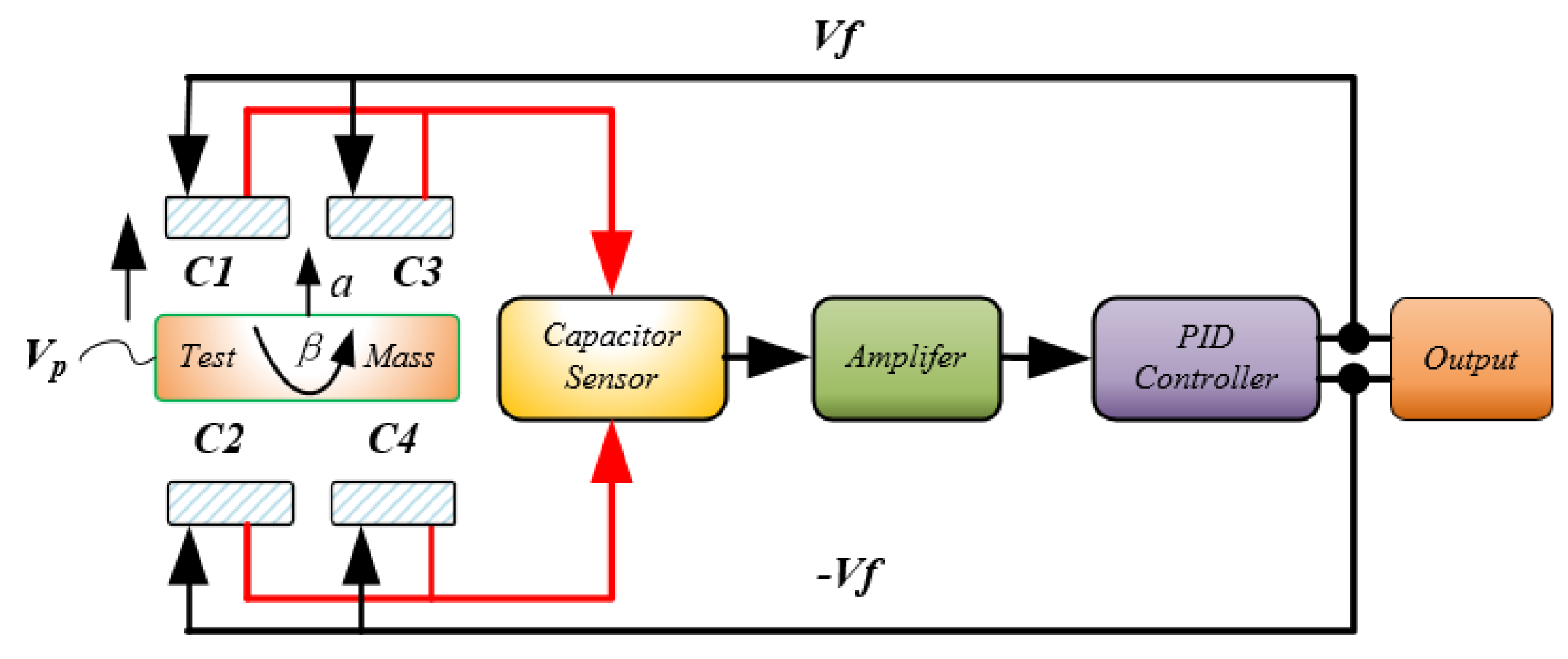
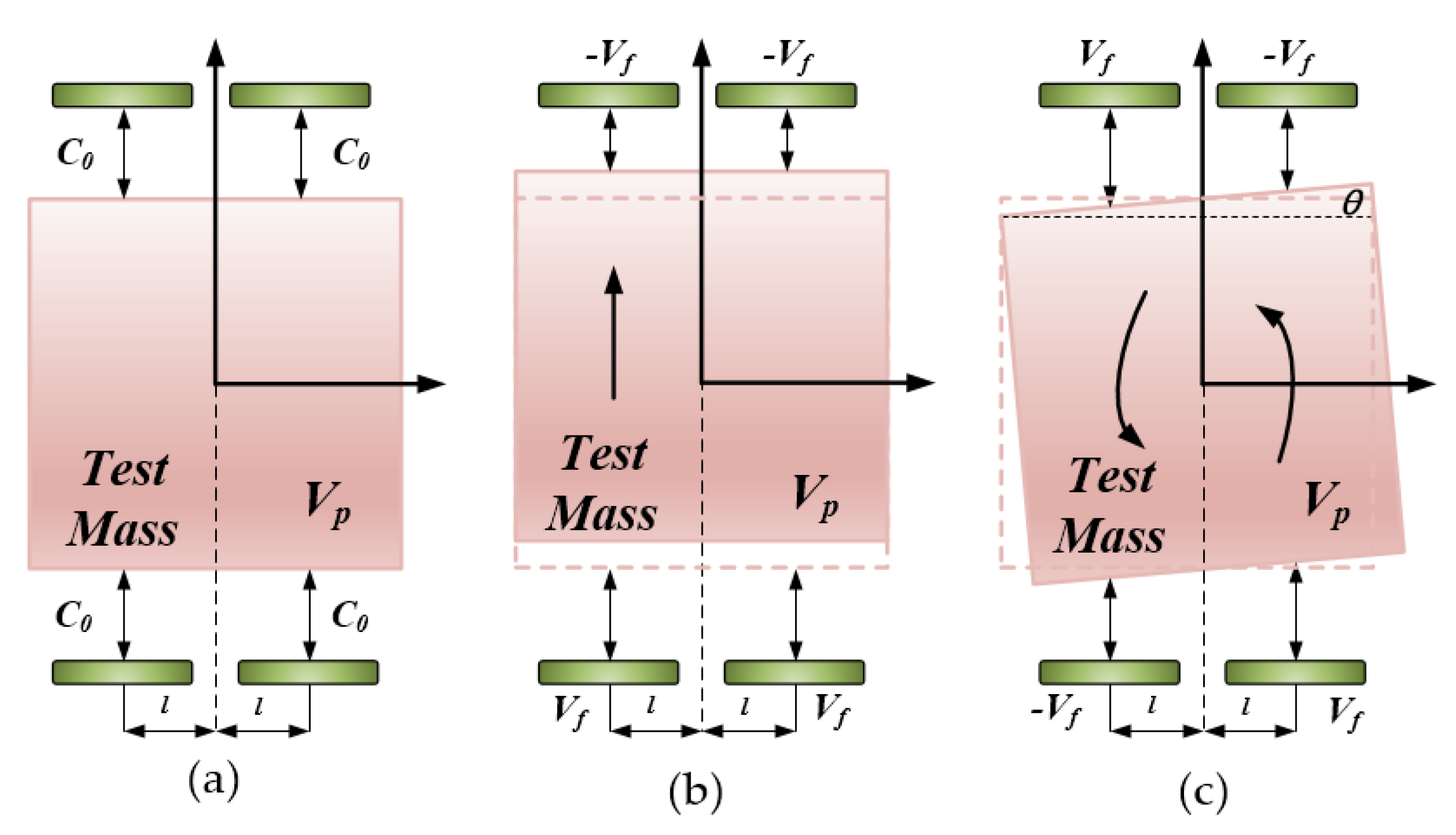
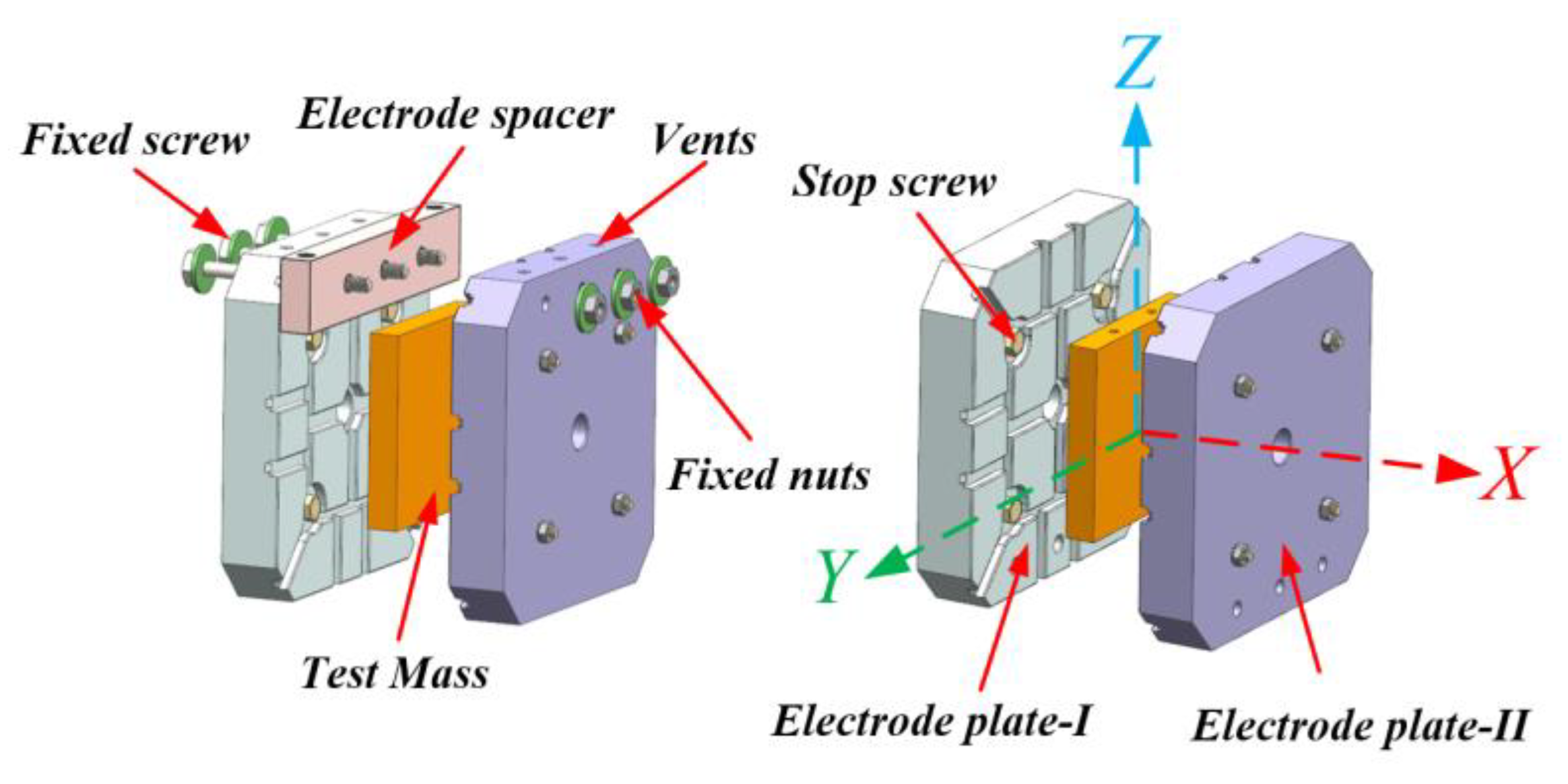
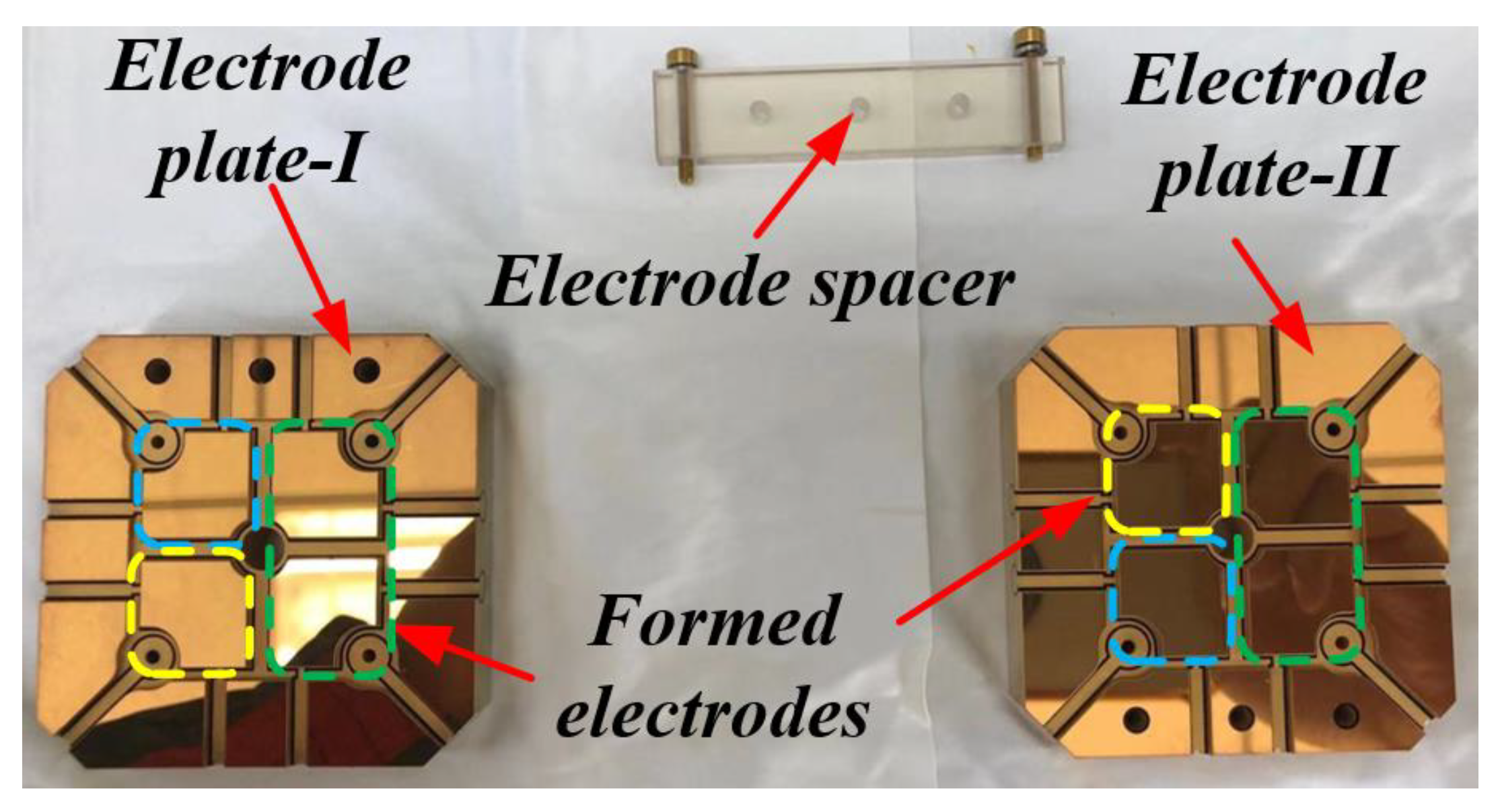
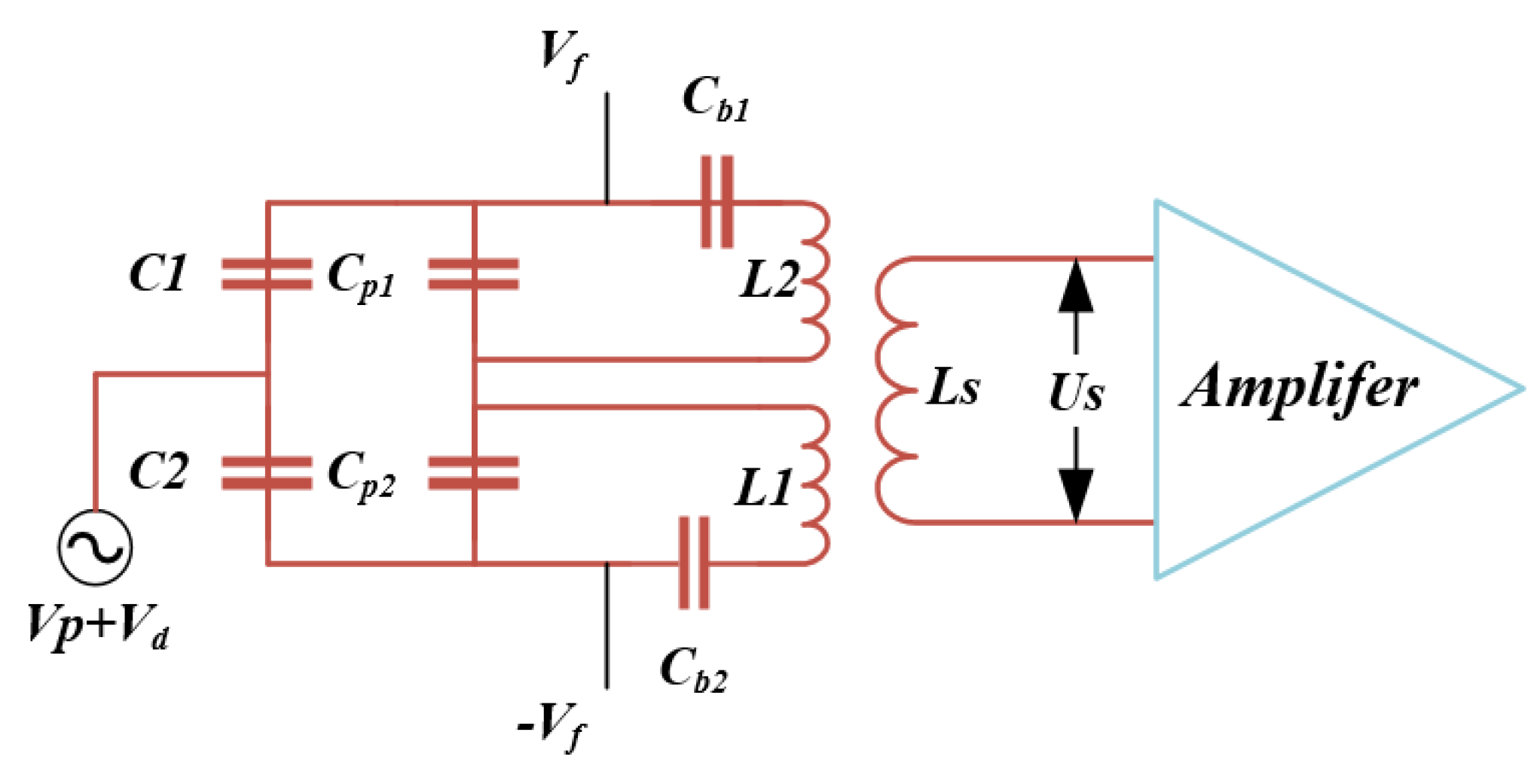
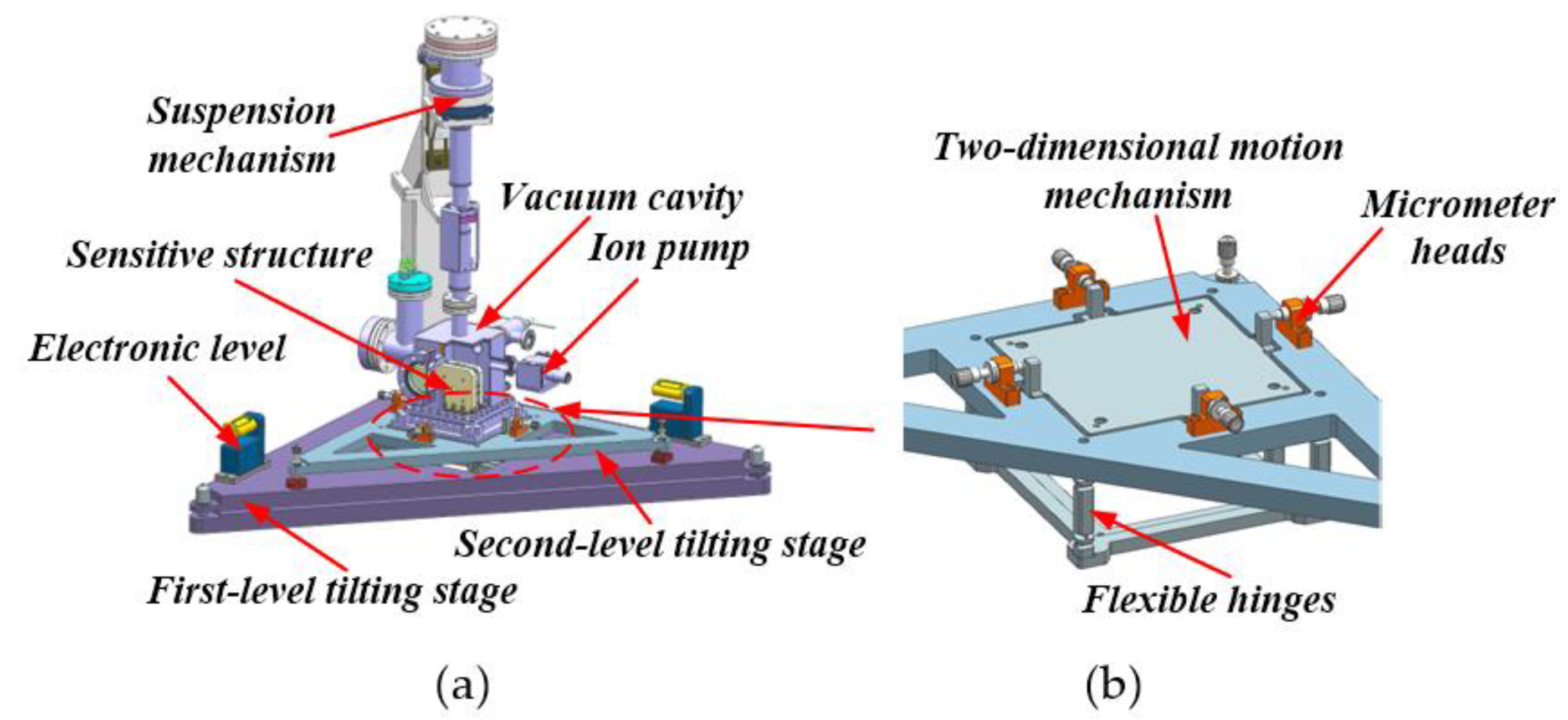
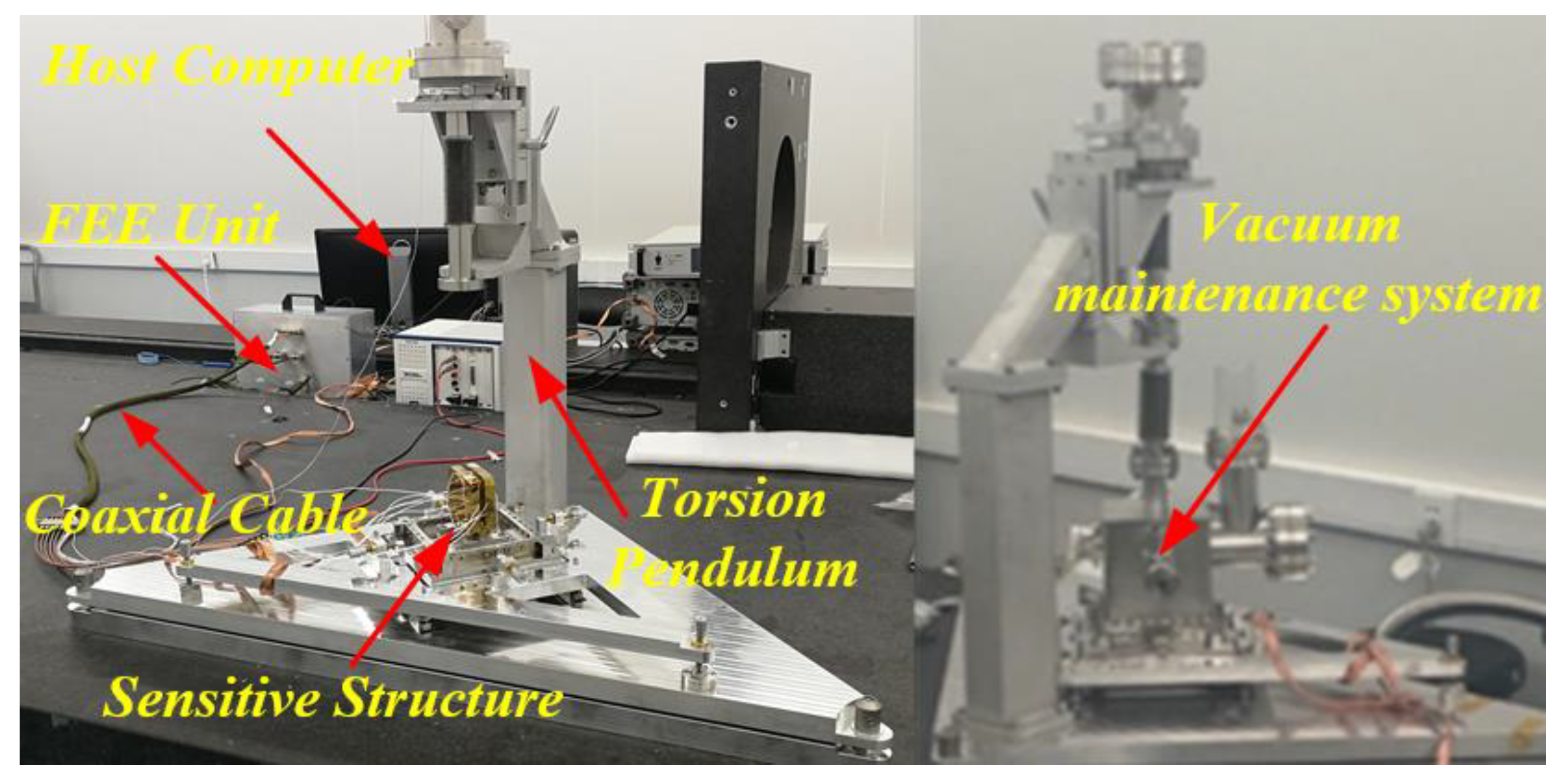
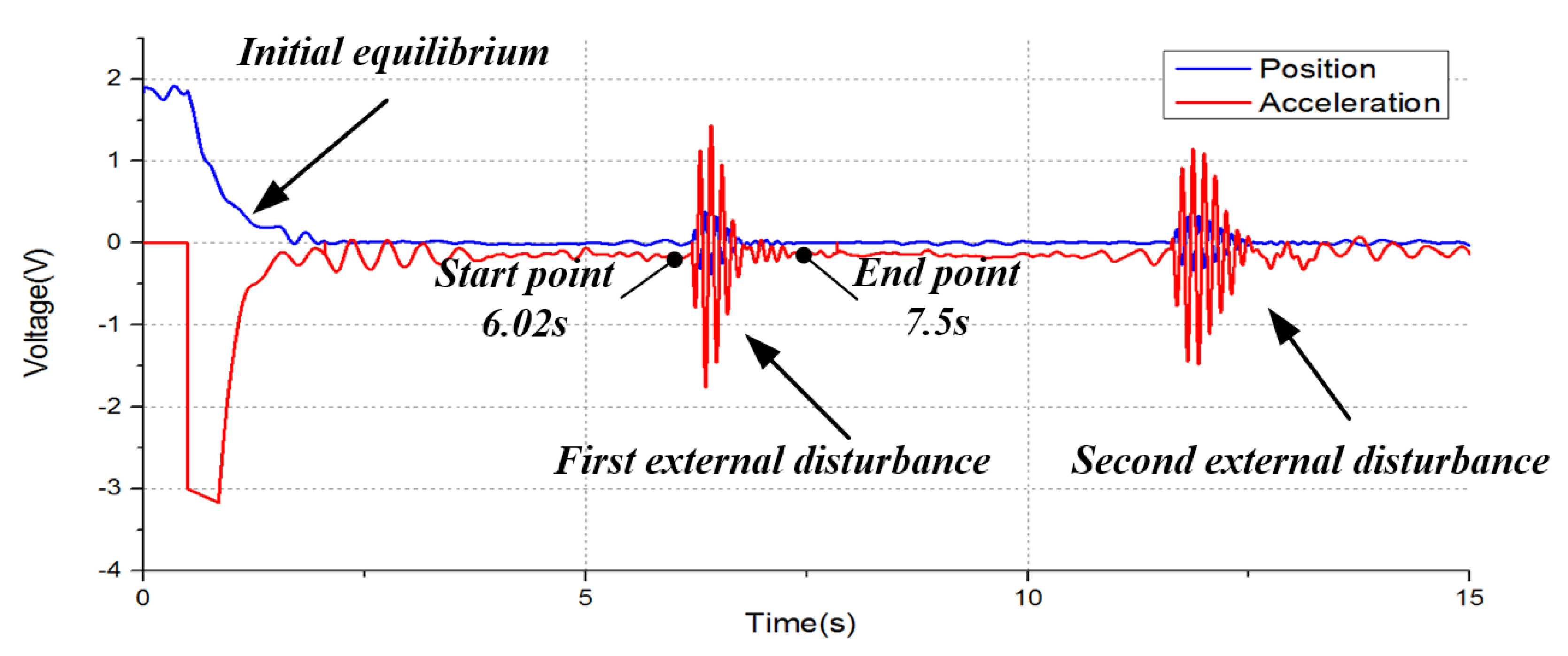

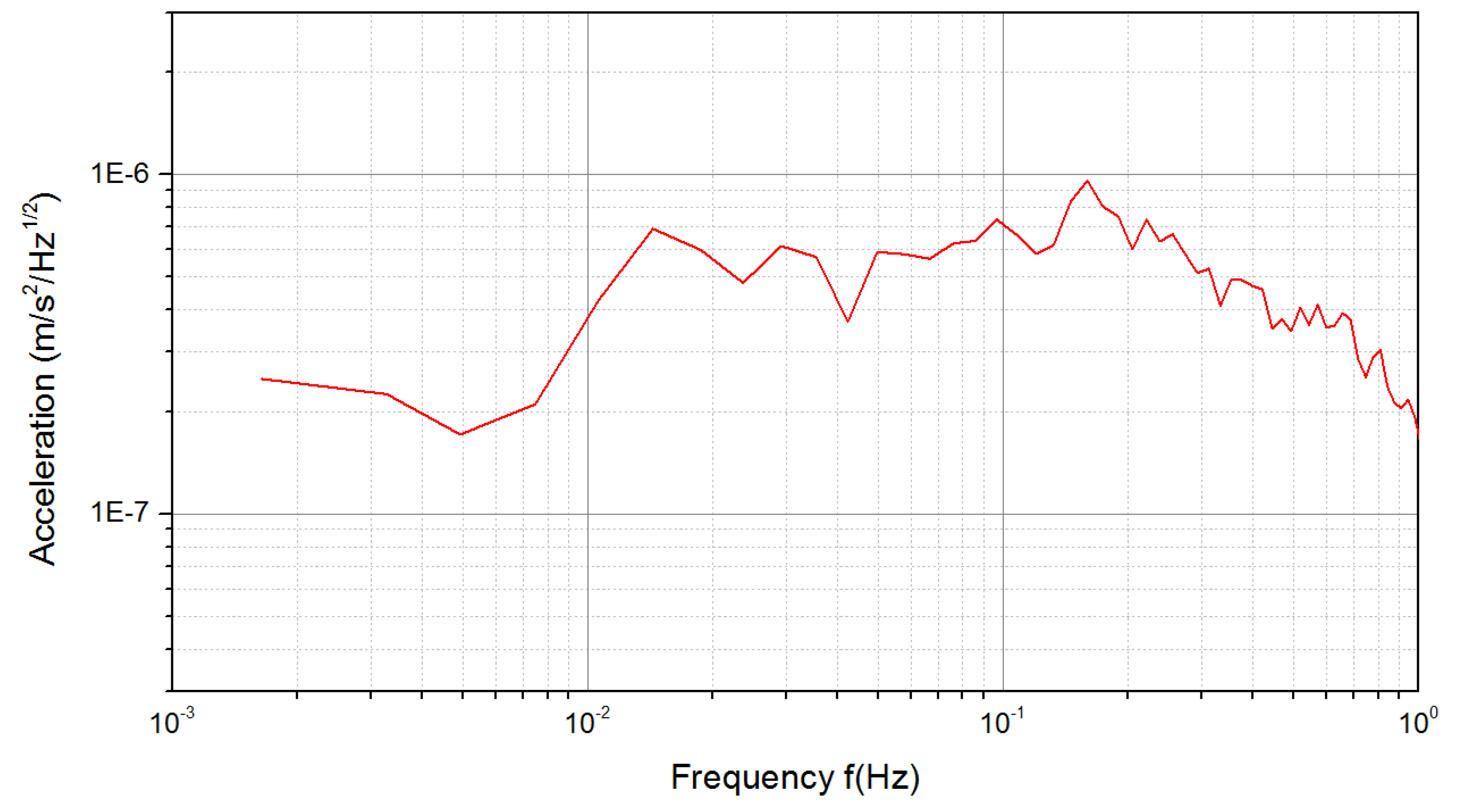
| Parameter Content | Value | Tolerance |
|---|---|---|
| TM size | 40 mm × 40 mm × 6.4 mm | ±0.002 mm |
| TM weight | 42 g | ±1 g |
| Spacer thickness | 6.64 mm | ±0.001 mm |
| Distance between TM and EH | 120 μm | ±0.003 mm |
| Area of electrode X1 | 473.56 mm2 | 0.2% |
| Area of electrode X2 | 236.98 mm2 | 0.2% |
| Area of electrode X3 | 236.86 mm2 | 0.2% |
| Element | Value | Comment |
|---|---|---|
| C1, C2 | 53 pF | Equilibrium value |
| Cp1, Cp2 | 1058 pF | Error: 10% |
| Cb1, Cb2 | 1 nF | Error: 10% |
| L1, L2, Ls | 4.5 mH | Error: 8% |
| Parameter | Value |
|---|---|
| Bias Voltage Vp | 5 V |
| Effective value of sensing voltage Vd | 4 V |
| Frequency of sensing voltage | 100 kHz |
| Peak of feedback voltage | ±10 V |
| Parameter | Value | Comment |
|---|---|---|
| 1 | Relative permittivity | |
| Vacuum dielectric constant | ||
| 293 K | Environment temperature | |
| Temperature fluctuation | ||
| 947.4 mm2 | Area of electrode X1, X2, X3 | |
| 0.2% | Deviation of electrode area | |
| 120 μm | Distance between TM and EH | |
| Degree of vacuum | ||
| 42 g | Mass of TM | |
| Coupling coefficient between TM and EH | ||
| Environmental maximum possible noise | ||
| 0.55 m | Suspension wire length | |
| Bias voltage fluctuation | ||
| Sensing voltage fluctuation | ||
| Feedback voltage fluctuation | ||
| 10 V | Peak of the feedback voltage | |
| Position measurement noise |
| Axis | Thermal Gradient | Earth Pulsation | Electrode Parallelism Error | Electrode Area Asymmetry | Detection Noise | Drive Noise | Total |
|---|---|---|---|---|---|---|---|
| X | 1.5 × 10−10 | 1 × 10−6 | 5 × 10−11 | 3.6 × 10−12 | 6.8 × 10−10 | 3.9 × 10−9 | 1 × 10−6 |
© 2020 by the authors. Licensee MDPI, Basel, Switzerland. This article is an open access article distributed under the terms and conditions of the Creative Commons Attribution (CC BY) license (http://creativecommons.org/licenses/by/4.0/).
Share and Cite
Wang, S.; Chen, L.; Wang, Y.; Zhou, Z.; Qi, K.; Wang, Z. A Space Inertial Sensor Ground Evaluation System for Non-Sensitive Axis Based on Torsion Pendulum. Appl. Sci. 2020, 10, 3090. https://doi.org/10.3390/app10093090
Wang S, Chen L, Wang Y, Zhou Z, Qi K, Wang Z. A Space Inertial Sensor Ground Evaluation System for Non-Sensitive Axis Based on Torsion Pendulum. Applied Sciences. 2020; 10(9):3090. https://doi.org/10.3390/app10093090
Chicago/Turabian StyleWang, Shaoxin, Liheng Chen, Yukun Wang, Zhenping Zhou, Keqi Qi, and Zhi Wang. 2020. "A Space Inertial Sensor Ground Evaluation System for Non-Sensitive Axis Based on Torsion Pendulum" Applied Sciences 10, no. 9: 3090. https://doi.org/10.3390/app10093090
APA StyleWang, S., Chen, L., Wang, Y., Zhou, Z., Qi, K., & Wang, Z. (2020). A Space Inertial Sensor Ground Evaluation System for Non-Sensitive Axis Based on Torsion Pendulum. Applied Sciences, 10(9), 3090. https://doi.org/10.3390/app10093090






